Complete Solutions to ADDITIONAL SOLVED PROBLEMS of chapter DYNAMICS of Class 11 book with complete answers and questions
| Class 11 | PHYSICS |
| Chapter | DYNAMICS |
| S CHAND | ADDITIONAL SOLVED PROBLEMS |
| Number Of Questions | 100 |
| Academic Year | 2023-24 |
A body starts from rest and slides down an inclined plane (assumed to be frictionless) of length 15m in 15s. Find
Its acceleration.
View SolutionA body starts from rest and slides down an inclined plane (assumed to be frictionless) of length 15m in 15s. Find
Its speed at the bottom of the plane.
View SolutionStarting from rest a hundred metre runner increases his speed uniformly at the rate of `1 ms^(-2)` upto three quarters of the total run and covers the last quarter with uniform speed. Find the time taken to cover the 1st half and the 2nd half?
View SolutionStarting from rest a car moves with uniform acceleration and attains a velocity of `10 ms^(-1)` in 10s. It then moves with uniform speed for 15s and is then brought to rest in 12s under uniform retardation. Find the total distance covered using velocity-time graph?
View SolutionA train moving with uniform acceleration is found to travel 55m and 65m respectively in 4th and 5th second. Find its initial velocity and acceleration?
View SolutionA stone is thrown vertically upwards with a velocity of `4.9 ms^(-1)`. Calculate
The maximum height reached.
View SolutionA stone is thrown vertically upwards with a velocity of `4.9 ms^(-1)`. Calculate
The time taken to reach the maximum height.
View SolutionA stone is thrown vertically upwards with a velocity of `4.9 ms^(-1)`. Calculate
The velocity with which it returns to the ground.
View SolutionA stone is thrown vertically upwards with a velocity of `4.9 ms^(-1)`. Calculate
The time taken to reach the ground.
View SolutionA stone is thrown vertically up from the top of a tower with a velocity of `5 ms^(-1)`. It reaches the ground after 8s. Find the height of tower?
View SolutionA stone is dropped from the top of a tower 200m high and at the same time another is projected vertically upwards from the ground with a velocity of `50 ms^(-1)`. Find where and when the two will meet?
View SolutionA body is dropped from a balloon rising vertically with a uniform velocity `12.25 ms^(-1)`, when the balloon is at a height `61.25m` in above the ground. Find
The maximum height reached by the body.
View SolutionA body is dropped from a balloon rising vertically with a uniform velocity `12.25 ms^(-1)`, when the balloon is at a height `61.25m` in above the ground. Find
The time taken by the body to reach the ground.
View SolutionA body is dropped from a balloon rising vertically with a uniform velocity `12.25 ms^(-1)`, when the balloon is at a height `61.25m` in above the ground. Find
The velocity with which it reaches the ground.
View SolutionA bomb is dropped from an aeroplane flying horizontally at `360 km"/"hr` when it is just above a target. Where will it hit the ground if the plane is `196m` above the ground?
View SolutionA stone is dropped into a well of depth 196m. The sound of splash is heard after `6.88 s`. Find the velocity of sound in air?
View SolutionA stone is dropped from rest from a point `0.4m` above a window `0.5m` high. Find the time taken by the stone to pass against the window?
View SolutionTwo trains A and B of length 400 m each are moving on two parallel tracks with uniform speed of `72 kmhr^(-1)` in the same direction with A ahead of B. The driver of B decides to overtake A and accelerates by `1 ms^(-2)`. If after 50 s the guard of B just brushes past the driver of A, what was the original distance between them?
View SolutionOn a two lane road, a car A is travelling with a speed of `36 kmhr^(-1)`. Two cars B and C approach car A in opposite direction with a speed of `54 kmhr^(-1)` each. At a certain instant, when the distance AB equals AC, both being 1 km, B decides to overtake A before C does. What maximum acceleration for B is required to avoid an accident ?
View SolutionA boy standing on a stationary lift ( open from above )throws a ball upward with the maximum initial speed he can, enqual to `49 ms^(-1)`. How much time does the ball take to return to his hands? If the lift starts moving up with uniform speed of `5ms^(-1)`and the boy again throws the ball up with the maximum speed he can, how long does the ball take to return to his hands?
View SolutionA police van moving on a highway with a speed of `30 km"/"h` fires a bullet at a theif's car speeding away in the same direction with the speed of `192 km"/"h`. If the muzzle speed of bullet is `150 ms^(-1)` with what speed does the bullet hit the thief's car?
View SolutionThe displacement of particle moving along a straight line is `x = b_(0) + b_(1) t + b_(2)t^(2)`. Find the acceleration.
View SolutionA car covers the first half of distance bwtween two places at a speed of `40km"/"h` our and the second half at `60 km"/"h`. What is the average speed of car?
View SolutionA body travels 2m in the first two seconds and `2.2 m` in the next four seconds.
What will be the velocity at the end of the seventh second from the start?
View SolutionA car travels from the place A to B with a speed `v_1`. During its return journey from B to A its speed is `v_(2)`. Find the average speed.
View SolutionA car travels for the first half time with a speed `v_(1)` and for the other half time with a speed `v_(2)`. Find the average speed.
View SolutionThe taken by a person in a boat to travel from a point A to B is `t_(1)` while going down stream and `t_(2)` while going upstream. Show that the time taken by the person with the motor shut off while going downstream in the river is `t_(3) = (2t_(1)t_(2))/(t_(2) -t_(1))`.
View SolutionA car accelerates from rest at a constant rate `alpha` for some time t, after which it retards at a constant rate `beta` to come to rest. The total time taken for the trip is t. Find the maximum velocity reached and the total distance convered graphically.
View SolutionAn escalator carries a person standing on it at rest through a height in `t_(1)s`. When the escalator is at rest the person takes `t_(2)s` to walk through the same height. Calculate the time t taken by the person to walk through the same height when the escalator moves with the same speed as in the first case.
View SolutionThe driver of a train moving at a speed u sights a freight train at a distance d ahead of him on the same track moving in the same direction with a slower speed v. He puts on the brakes and gives his train a constant deceleration a. Show that if `d gt ((u-v)^2)/(2a)`, there will be no collision and if `d lt ((u-v)^2)/(2a)`, there will be a collision.
View SolutionIf a body travels half its total path in the last second of its fall from rest, find the time and height of its fall.
View SolutionWater drips from thr nozzle of a shower onto the floor `2.45m` below. The drops fall at regular intervals of time, the first drop striking the floor at the instant the fourth drop begins to fall. Find the location of the individual drops when a drop strikes the floor.
View SolutionA stone is dropped from the top of a tower of height 49m and another one is thrown vertically down one second after the first is dropped. Both stones hit the ground at the same time. Find the initial velocity of the second stone?
View SolutionA parachutist bails out and freely falls 49m. Then the parachute opens, and thereafter he decelerates at `2 m"/"s^(2)`. He reaches the ground with a speed of `3.0 m"/"s`
How long is the parachutist in the air?
View SolutionA parachutist bails out and freely falls 49m. Then the parachute opens, and thereafter he decelerates at `2 m"/"s^(2)`. He reaches the ground with a speed of `3.0 m"/"s`
At what height did the fall begin?
View SolutionA boy stands at a place on a bridge which is 10m above the water surface. He throws a stone vertically upwards with a speed `20 m"/"s`
How high above the bridge will the stone rise ? `(g = 10 m"/"s^(2))`.
View SolutionA boy stands at a place on a bridge which is 10m above the water surface. He throws a stone vertically upwards with a speed `20 m"/"s`
After how many seconds from the start will the stone hit the water surface?
View SolutionA boy stands at a place on a bridge which is 10m above the water surface. He throws a stone vertically upwards with a speed `20 m"/"s`
If the boy throws another stone horizontally with the same speed `(20 m"/"s)` how long will it take to hit the water surface?
View SolutionA boy stands at a place on a bridge which is 10m above the water surface. He throws a stone vertically upwards with a speed `20 m"/"s`
Had the boy simply dropped the stone, how much time would have been taken by the stone to hit the water surface?
View SolutionA boy stands at a place on a bridge which is 10m above the water surface. He throws a stone vertically upwards with a speed `20 m"/"s`
What is the distance between the points where the stone strikes the water surface in c and d above?
View SolutionA balloon is ascending at the rate of `10 ms^(-1)` at a height of 40m above the ground, when a package is dropped. How long will it take for the package to reach the ground?
View SolutionA boy stands on the top a tower 490 m above the ground and throws a ball horizontally with an initial speed of `54 km"/"hr`. Find the time taken by the ball to reach the ground and the speed with which it hits the ground.
View SolutionA body is projected with a velocity of `30 ms^(-1)` at an angle of `30^(@)` with the vertical. Find the maximum height, time of fight and the horizontal range.
View SolutionA projectile is thrown with a velocity `49 m"/"s` in the upward direction making an angle 30 with the horizontal. Find the velocity after 2s ?
View SolutionShow that for a given velocity of projection and horizontal range there are two angles of projection equally inclined to horizontal and vertical directions.

View SolutionProve that the time of flight T and the horizontal range R of a projectile are connected by the equation `gT^(2) = 2 R tan (theta)`, where `theta` is the angle of projection.
View SolutionProve that for a projectile the range for any angle, any number of degrees greater than ` 45^(@)` will be equal to the range for an angle which is equal number of degrees less than `45^(@)` ?
View SolutionTwo projectiles are projected into air at an angle `90 - alpha` from the same point with a velocity `49 ms^(-1)`. Then the second one rises `19.6 m` higher than the first. Find the individual heights ?
View SolutionAn aircraft is flying at a height of 3400 m above the ground. If the angle subtended at a ground observation point by the aircraft positions 10 s apart is `30^(@)`, what is the speed of the aircraft ?

View SolutionA bullet fired at an angle `30^(@)` with the horizontal hit the ground 3 km away. By adjusting its angle of projection, can one hope to hit a target 5 km away ? Assume the muzzle speed to be fixed and neglect air resistance.
View SolutionThe ceilling of a long hall is 25 m hight. What is the maximum horizontal distance that a ball thrown with a speed of `40 ms^(-1)` can go without hitting the ceilling of the hall ?
View SolutionA machine gun is mounted on the top of a tower 100 m hight. At what angle should the gun be inclined to cover a maximum range of firing on the ground below ? The muzzle speed of the bullet is `150 ms^(-1)`.
[Take `g = 10 ms^(-2)`]
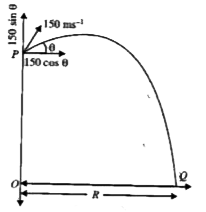
View SolutionA cricketer can throw a ball to a maximum horizontal distance of 100 m. How much high above the ground can the cricketer throw the same ball ?
View SolutionA fighter plane flying horizontally at an altitude of 15 km with speed `720 kmh^(-1)` passes directly overhead an antiaircraft gun. At what angle from the vertical should the gun be fired for the shell muzzle speed `600 ms^(-1)` to hit the plane ? At what maximum altitude should the pilot fly the plane to avoid being hit ? (take `g = 10 ms^(-2)`)
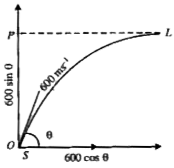
View SolutionIf `T_(1)" and "T_(2)` are the times of flight of a projectile for two angles of projection `theta_1` and `theta_2` such that `theta_(1)+theta_(2)= 90^(@)`, show that `T_(1)T_(2) = (2R)/(g)` where R is the horizontal range of the projectile.
View SolutionA ball rolls off the edge of a horizontal table top 1 m high. If it strikes at a point 2 m horizontally away from the edge of the table, what was its speed at the instant it left the table ?
View SolutionFind the angle of projection at which the horizontal range and the maximum height of a projectile are equal.
View SolutionShow that if the acceleration due to gravity changes by an amount dg, the range of a projectile changes by dR such that `dR"/"R = - dg"/"g`.
View SolutionA ball rolls off the top of a stairway with a horizontal velocity of magnitude `2.76 m"/"s`. The steps are 20 cm high and 20 cm wide. Which step will the ball hit first ?
View SolutionA football is kicked off with an initial speed of `19.6 m"/"s` at angle of `45^(@)` with the horizontal. A receiver on the goal line 70 m away in the direction of the kick, starts running to meet the ball at that instant. Find his speed if he is to catch the ball before it hits the ground ?
View SolutionA hunter aims his gun and fires a bullet directly at a monkey on a tree. At the instant the bullet leaves the barrel of gun, the monkey drops. Will the bullet hit the monkey ? Explain ?
View SolutionRain is falling vertically with a speed of `30 ms^(-1)`. A woman rides a bicycle with a speed of `10 ms^(-1)` in the north to south direction. What is the direction in which she should hold her umbrella ?
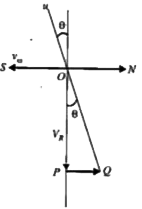
View SolutionA boatman can row with a speed for `10 km"/"h` in still water. If the river flows steadily at `5 km"/"h`, in which direction th boat man row in order to reach a point on the other bank directly opposite to the point from where he started ? The width of the river is 2 km.
View SolutionA boat travelling due north crosses a wide river with a speed of `15 km"/"h` relative to water. The river flows with a uniform spedd of `3 km"/"h` due east relative to earth. What is the velocity of the boat relative to a stationary ground observer ?
View SolutionA constant force acting on a body of mass 3 kg changes its speed from `2 ms^(-2)" to "3.5 ms^(-1)` in 25 s. The direction of motion of the body remains unchanged. What is the magnitude and direction of the force ?
View SolutionGive the magnitude and direction of the net force acting on
A drop of rain falling down with a constant speed .
View SolutionGive the magnitude and direction of the net force acting on
A cork of mass 10g floating on water.
View SolutionGive the magnitude and direction of the net force acting on
A stone of mass `0.1 kg` just after it is dropped from the window of a train running
At a constant velocity of `36 km"/"h`.
View SolutionGive the magnitude and direction of the net force acting on
A stone of mass `0.1 kg` just after it is dropped from the window of a train running
With a constant acceleration of `1 ms^(-2)`.
View SolutionA train of mass 200 ton running at a speed of `72 km"/"h` along a level road comes to rest in a distance of `(1)/(2) km`. Find the force of deceleration ?
View SolutionA bullet of mass 40 gm, travelling with a velocity of `18 m"/"s` penetrates a thin mud wall and is brought to rest in `0.06s`. Find the depth of penetration and the average retarding force of the mud wall ?
View SolutionA constant retarding force of 50 N is applied to a body of mass 20 kg moving initially with a speed of `15 ms^(-1)`. How long does the body take to stop ?
View SolutionA stream fo water flowing horizontally with a speed of `15 ms^(-1)` gushes out of a tube of cross-sectional area `10^(-2) m^(2)`, and hits at a vertical wall nearby. What is the force exerted on the wall by the impact of water, assuming it does not rebound ?
View SolutionA particle of mass `0.4 kg` moving with a constant speed of `10 ms^(-1)` to the north is sujected to a constant force of 8 N directed towards the south for 30 s. Take the instant the force is applied to be t = 0, and predict its position at `t = - 5s, 100s`.
View SolutionA car starts from rest and accelerates uniformly with `2 ms^(-2)`. At t = 10 s, a stone is dropped out of the window (1 m high) of the car. What are the
Velocity.
View SolutionA car starts from rest and accelerates uniformly with `2 ms^(-2)`. At t = 10 s, a stone is dropped out of the window (1 m high) of the car. What are
Acceleration of the stone at `t = 10.1s` ?
View SolutionA hammer weighing 3 kg moving with a velocity of `10 ms^(-1)` strikes horizontally against the head of a nail driven it into a block of wood. If the hammer comes to rest in `0.025s`, find
The impulse.
View SolutionA hammer weighing 3 kg moving with a velocity of `10 ms^(-1)` strikes horizontally against the head of a nail driven it into a block of wood. If the hammer comes to rest in `0.025s`, find
The driving force on the nail.
View SolutionA cricket ball of mass 200 gm and bowled at `20 ms^(-1)` is hit and returned straight in the opposite direction with a velocity of `10 ms^(1)`. Find the impulse and impulsive force, if the time of contact of ball and bat is `0.05s` ?
View SolutionA rocket consumes 250 gm of fuel per second and ejects the gas with a speed of `8 km"/"s`. Calculate the thrust exerted on the rocket by the ejected gas ?
View SolutionTwo table tennis balls strike a rigid wall with same speed u but at different angles as shown in the Fig. 4.3.20. What is the impulse imparted on the wall in each case ?

View SolutionA batsman deflects a ball by an angle of `45^(@)` without changing its initial speed equal to `54 km"/"h`. What is the impulse imparted to the ball ? Mass of ball is equal to `0.15kg`.
View SolutionA body of mass 1 kg is initially at rest. It explodes into three pieces of masses in the ratio `1 : 1 : 3`. Two pieces of equal masses fly off perpendicular to each other with a speed of `30 m"/"s`. What is the velocity of the heavier mass ?
View SolutionA man weighs 70 kg. He stands on a weighing scale in a lift which is moying
Upwards with a uniform speed of `10 ms^(-1)`.
What would be the reading of the scale in each case ? What would be the reading if the lift mechanism failed and it hurtled down freely under gravity ?
View SolutionA man weighs 70 kg. He stands on a weighing scale in a lift which is moying
Downwards with a uniform acceleration of `5 ms^(2)`.
What would be the reading of the scale in each case ? What would be the reading if the lift mechanism failed and it hurtled down freely under gravity ?
View SolutionA man weighs 70 kg. He stands on a weighing scale in a lift which is moying
Upwards with a uniform acceleration of `5 ms^(-2)`.
What would be the reading of the scale in each case ? What would be the reading if the lift mechanism failed and it hurtled down freely under gravity ?
View SolutionA horizontal force of 500 N pulls two masses 10 kg and 20 kg (lying on a frictionless table) connected by a light string. What is the tension in the string ? Does the answer depend on which mass end the pull is applied.
 .
.
View SolutionA helicopter of mass 1000 kg rises with a vertical acceleration of `15 ms^(-2)`. The crew and the passengers weigh 300 kg. Give the magnitude and direction of
Force on the floor by the vrew and passengers.
View SolutionA helicopter of mass 1000 kg rises with a vertical acceleration of ` 15 ms^(-2)`. The crew and the passengers weigh 300 kg. Give the magnitude and direction of
Action of the rotor of the helicopter on the surrounding air.
View SolutionA helicopter of mass 1000 kg rises with a vertical acceleration of `15 ms^(-2)`. The crew and the passengers weigh 300 kg. Give the magnitude and direction of
Force on the helicopter due to the surrounding air (Take `g = 10 ms^(-2)`).
View SolutionA monkey of mass 15 kg is climbing a massless rope passing over a frictionless pulley to the free end of which is attached a 25 kg mass
How can the monkey climb up the rope so that it can raise the 25 kg mass off the ground ?
View SolutionA monkey of mass 15 kg is climbing a massless rope passing over a frictionless pulley to the free end of which is attached a 25 kg mass
After raising the mass from the ground if the monkey stops climbing and holds to the rope, what is the acceleration of the monkey and the tension in the rope?
View SolutionA plumb line is hanging from the roof of a car. What is the horizontal acceleration of a car when the bob is displaced by `50^(@)` from the vertical ?
View SolutionTo two ends a light staring of length l two equal masses m each are attached as shwon in Fig 4.3.27 (b). At the midpoint of the string a constant force F is applied at right angles to the initial position of the string. Prove that the acceleraion of the mass in the direction at right angle to F is
`a_(x) = (Fx)/(2m sqrt((l^2)/(4)- x^(2)))`
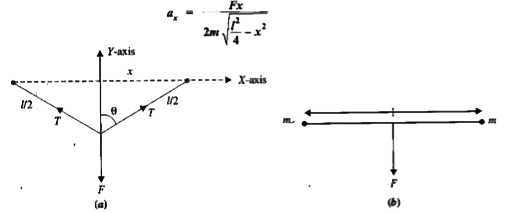
View SolutionTwo masses `m_(1)" and "m_(2)` are attached to two ends of a massless string passing over a frictionless massless pulley and `m^(2)` is placed on an inclined plane. Assuming that the friction between the mass `m^(2)` and the plane is zero find the acceleration of the masses and the tension in the string if `m_(1) = 20.5 kg, m^(2) = 10.5 kg" and "theta = 45^(@)`.
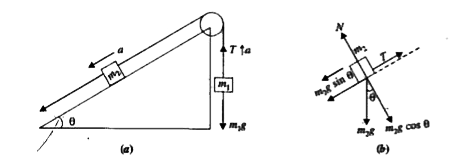
View SolutionA spring balance is attached to the roof off an elevator nad a body of mass m is suspended from the balance. What is the weight of the body when the elevator accelerates.
Upward.
View SolutionA spring balance is attached to the roof off an elevator nad a body of mass m is suspended from the balance. What is the weight of the body when the elevator accelerates.
Downward?
View SolutionTwo masses `m_(1) " and " m_(2)` are attached to a spring balnace as shwon in Fig. 4.3.30.
What is the acceleration of the system if `m_(1) gt m_(2)`, and the mass of the spring balance is m ?
View SolutionTwo masses `m_(1) "and" m_(2)` are attached to a spring balnace as shwon in Fig. 4.3.30.
If the spring balance is of negligible mass and `m_(1) = m_(2) = 10 kg`, what is its reading ?
View SolutionWhat is the magnitude of the acceleration of the system shown in Fig. 4.3.31 ? Also calculate the tension in the string. Given `alpha = 60^(@), beta = 30^(@) m_(1) = 4 kg, m_(2) = 2 kg`.
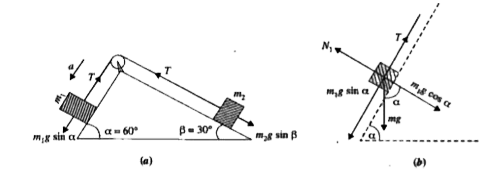
View Solution
ADDITIONAL SOLVED PROBLEMS questions and complete solutions for chapter DYNAMICS of S CHAND PHYSICS (ENGLISH) of Class 11